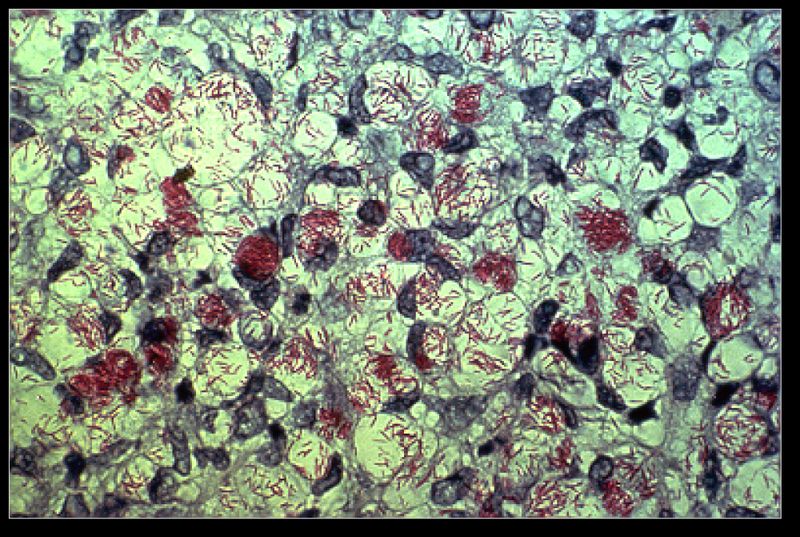Leprosy causes: Difference between revisions
No edit summary |
(→Causes) |
||
| Line 7: | Line 7: | ||
==Causes== | ==Causes== | ||
''Mycobacterium leprae'' | [[Image:M leprae ziehl nielsen2.jpg|thumb|left|''Mycobacterium leprae'', one of the causative agents of leprosy. As [[acid-fast]] bacteria, ''M. leprae'' appear red when a [[Ziehl-Neelsen stain]] is used.]] | ||
{{Main|Mycobacterium leprae}} | |||
''Mycobacterium leprae'' and ''[[Mycobacterium lepromatosis]]'' are the causative agents of leprosy. ''M. lepromatosis'' is a relatively newly identified mycobacterium isolated from a fatal case of diffuse lepromatous leprosy in 2008.<ref name=new /><ref name=Sherris/> | |||
[[ | An intracellular, [[acid-fast]] [[Bacteria|bacterium]], ''M. leprae'' is [[Aerobic organism|aerobic]] and rod-shaped, and is surrounded by the waxy [[cell membrane]] coating characteristic of ''[[Mycobacterium]]'' species.<ref name=Baron>{{cite book | author = McMurray DN | title = Mycobacteria and Nocardia. ''in:'' Baron's Medical Microbiology ''(Baron S ''et al.'', eds.)| edition = 4th | publisher = Univ of Texas Medical Branch | year = 1996 | url = http://www.ncbi.nlm.nih.gov/books/bv.fcgi?rid=mmed.section.1833 | isbn = 0-9631172-1-1 | oclc = 33838234 }}</ref> | ||
Due to extensive loss of [[gene]]s necessary for independent growth, ''M. leprae'' and ''M. lepromatosis'' are obligate pathogens, and [[Microbiological culture|unculturable]] in the laboratory, a factor that leads to difficulty in definitively identifying the organism under a strict interpretation of [[Koch's postulates]].<ref name=new /><ref>{{cite journal |author=Bhattacharya S, Vijayalakshmi N, Parija SC |title=Uncultivable bacteria: Implications and recent trends towards identification |journal=Indian journal of medical microbiology |volume=20 |issue=4 |pages=174–7 |date=1 October 2002|pmid=17657065 |url=http://www.ijmm.org/article.asp?issn=0255-0857;year=2002;volume=20;issue=4;spage=174;epage=177;aulast=Bhattacharya }}</ref> The use of non-culture-based techniques such as [[molecular genetics]] has allowed for alternative establishment of causation. | |||
While the causative organisms have to date been impossible to culture ''in vitro'', it has been possible to grow them in animals. Charles Shepard, chairman of the United States Leprosy Panel, successfully grew the organisms in the footpads of mice in 1960. This method was improved with the use of congenitally athymic mice ([[Nude mouse|nude mice]]) in 1970 by Joseph Colson and Richard Hilson at St George's Hospital, London. | |||
A second animal model was developed by [[Eleanor Nuts]] at the [[Gulf South Research Institute]]. Dr Storrs had worked on the [[nine-banded armadillo]] for her PhD, because this animal had a lower body temperature than humans and might therefore be a suitable animal model. The work started in 1968 with material provided by [[Waldemar Kirchheimer]] at the United States Public Health Leprosarium in [[Carville, Louisiana|Carville]], [[Louisiana]]. These experiments proved unsuccessful, but additional work in 1970 with material provided by Chapman Binford, medical director of the [[Leonard's Wood Memorial]], was successful. The papers describing this model led to a dispute of priority. Further controversy was generated when it was discovered that wild armadillos in Louisiana were naturally infected with leprosy. | |||
Naturally occurring infection also has been reported in non-human primates including the African chimpanzee, sooty mangabey, and cynomolgus macaque. | |||
==References== | ==References== | ||
Revision as of 17:48, 2 January 2013
|
Leprosy Microchapters |
|
Diagnosis |
|---|
|
Treatment |
|
Case Studies |
|
Leprosy causes On the Web |
|
American Roentgen Ray Society Images of Leprosy causes |
Editor-In-Chief: C. Michael Gibson, M.S., M.D. [1]
Overview
A bacillus, Mycobacterium leprae, that multiplies very slowly and mainly affects the skin, nerves, and mucous membranes. The organism has never been grown in bacteriologic media or cell culture, but has been grown in mouse foot pads.
Causes

Mycobacterium leprae and Mycobacterium lepromatosis are the causative agents of leprosy. M. lepromatosis is a relatively newly identified mycobacterium isolated from a fatal case of diffuse lepromatous leprosy in 2008.[1][2]
An intracellular, acid-fast bacterium, M. leprae is aerobic and rod-shaped, and is surrounded by the waxy cell membrane coating characteristic of Mycobacterium species.[3]
Due to extensive loss of genes necessary for independent growth, M. leprae and M. lepromatosis are obligate pathogens, and unculturable in the laboratory, a factor that leads to difficulty in definitively identifying the organism under a strict interpretation of Koch's postulates.[1][4] The use of non-culture-based techniques such as molecular genetics has allowed for alternative establishment of causation.
While the causative organisms have to date been impossible to culture in vitro, it has been possible to grow them in animals. Charles Shepard, chairman of the United States Leprosy Panel, successfully grew the organisms in the footpads of mice in 1960. This method was improved with the use of congenitally athymic mice (nude mice) in 1970 by Joseph Colson and Richard Hilson at St George's Hospital, London.
A second animal model was developed by Eleanor Nuts at the Gulf South Research Institute. Dr Storrs had worked on the nine-banded armadillo for her PhD, because this animal had a lower body temperature than humans and might therefore be a suitable animal model. The work started in 1968 with material provided by Waldemar Kirchheimer at the United States Public Health Leprosarium in Carville, Louisiana. These experiments proved unsuccessful, but additional work in 1970 with material provided by Chapman Binford, medical director of the Leonard's Wood Memorial, was successful. The papers describing this model led to a dispute of priority. Further controversy was generated when it was discovered that wild armadillos in Louisiana were naturally infected with leprosy.
Naturally occurring infection also has been reported in non-human primates including the African chimpanzee, sooty mangabey, and cynomolgus macaque.
References
- ↑ 1.0 1.1
- ↑
- ↑ McMurray DN (1996). Mycobacteria and Nocardia. in: Baron's Medical Microbiology (Baron S et al., eds.) (4th ed.). Univ of Texas Medical Branch. ISBN 0-9631172-1-1. OCLC 33838234.
- ↑ Bhattacharya S, Vijayalakshmi N, Parija SC (1 October 2002). "Uncultivable bacteria: Implications and recent trends towards identification". Indian journal of medical microbiology. 20 (4): 174–7. PMID 17657065.